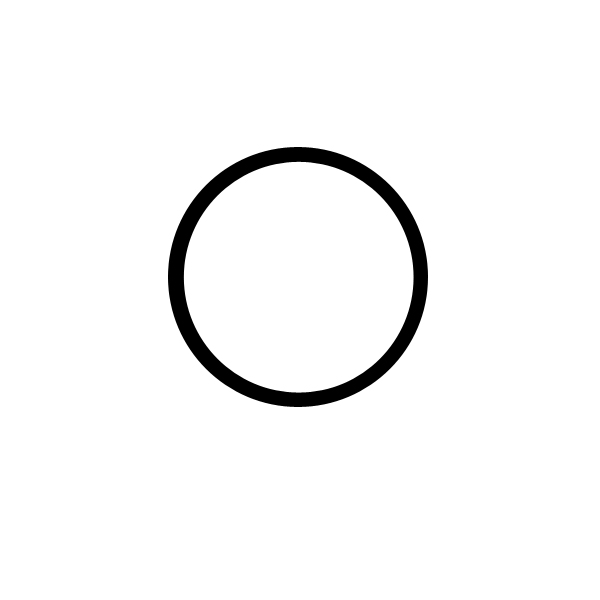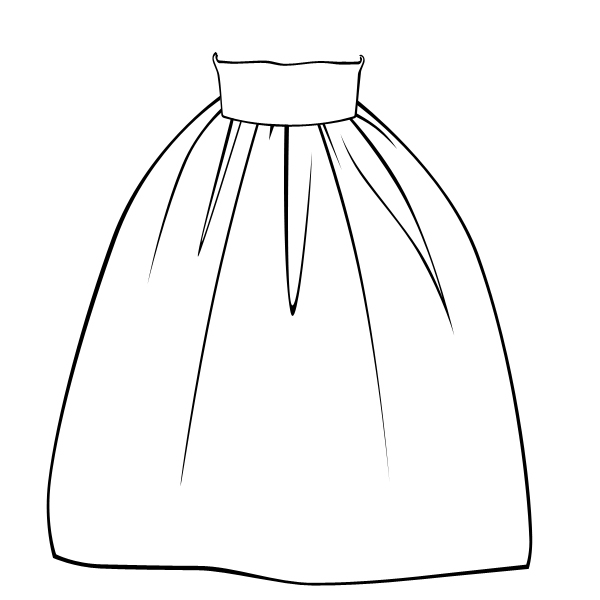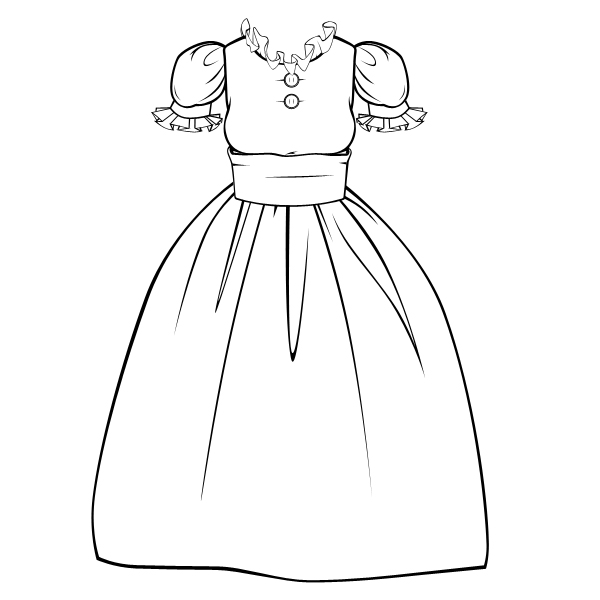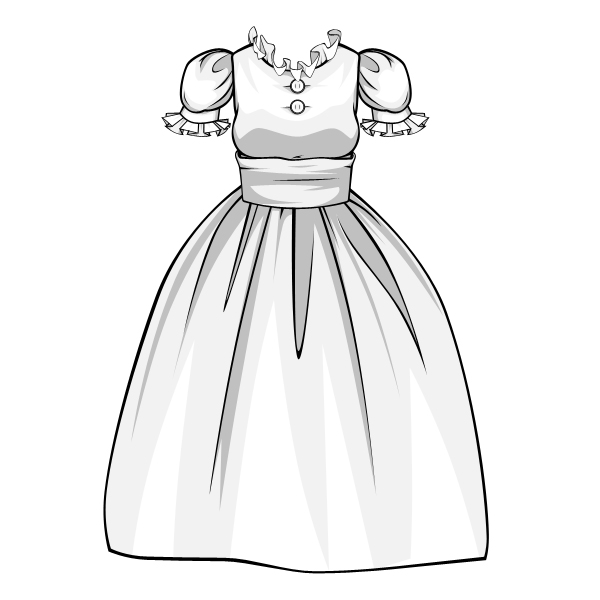Hello everyone! Even though creating a character is hard, drawing out their elaborate clothing is even more difficult. Here's an article that can help. I hope you enjoy. Happy Reading!!!!!
Difficulty:IntermediateLength:MediumLanguages:

Generally speaking, intricate designs all start with very simple shapes and are easy to create once you know how, but unless you know where to begin, it can prove to be challenging. This tutorial guides you through fabric movement and folds, continuing on to creating a few simple features of more intricate clothing design, which can then be used alongside each other to build up to a higher level of drawing clothing. This tutorial builds on the knowledge gained from my previous clothing tutorial, which was aimed at beginners.
1. Fabric Movement
Example 1
When it comes to drawing fabric and clothing, the first thing you'll need to consider is fabric movement, and how it will fall over the curves of your character's figure. Before you start drawing any clothing, take a look at fabric around you - your own clothing, for example - and how that works and where it folds, and why. Below are a few examples, using my trusty green curtain, of how fabric folds, and the different shapes it makes, and where the light falls in 'normal' lighting.
The first example is of the curtain just being a curtain, and it falls and folds vertically, the folds created by the bunching at the top. This example is useful should you wish to consider drawing long flowing skirts, dresses or cloaks.

Example 2
The fabric here is folded to fall in various directions, showing a great example of how lighting works with the various shadows and highlights within the shapes. These folds are more likely to be seen in an unmade bed than clothing, but could easily be incorporated into a more intricate design, such as a fantasy gown or wedding dress.

Example 3
This twisted 'rose' of fabric makes for a good general reference as it has all-sorts of shapes within it, twisting around to the middle. This fabric shape as a whole is most likely to be found as a design itself, sewn into, or on something, like a prom dress.

Example 4
Tightly bunched fabric like the top of a curtain is great to show an elastic seam, such as a skirt with an elasticated waist, or to show fabric gathered using, as an example, a thin piece of ribbon, which could be used in many places on clothing designs, such as sleeves.

2. Start With Basic Shapes
Step 1
When drawing clothing, it's best to start with the basic shapes and the anatomy of the design, as this will give you something to build on. To make sure your basic shape is symmetrical, you can draw half, duplicate and then flip it horizontally to create the other half. Even if your planned design isn't symmetrical, it's a good idea to start this way as you'll know everything will be level and in the right place before you begin.
You can download the basic dress shape below from the source files to use throughout this tutorial, in both PSD vector format and JPEG format.

3. Drawing Ruffles and Frills
Step 1
Before adding to the basic shape, you'll need to know how to draw the additions that you may want to use in the design, starting with ruffles and frills. First, draw a curved line.

Step 2
Underneath your line, and following its curve, add a wiggly line with similar shape to the one shown below.

Step 3
Add further lines to act as the fabric that forms the ruffles pointing upwards.

Step 4
Using straight connecting lines from the points of the lower ruffles toward the original curved line completes the frill look.

Step 5
Erase any superfluous lines, such as those areas in the original curve which overlap the 'tops' of the ruffles.

Step 6
Below are examples of other ideas and ruffle shapes for you to consider.

4. Drawing Buttons
Step 1
Buttons can come in all shapes and sizes, but they all follow the same sort of idea when it comes to drawing them. Start by drawing your button shape, in this case, a circle.

Step 2
Many buttons have small holes in them, which is how they are sewn on to the garment. Some buttons have instead a small loops at the back to attach them, it depends on the style of the button. Drawing a vertical line like the one shown below gives the impression of the cotton between two of the small holes on the button, holding it in place. Experiment with different styles of buttons, and consider how they're attached to the clothing.

Step 3
Add a second line, as shown below, for the other side. Unless your button design only features two holes (and therefore one piece of cotton to hold it in place, in the center) then you will need to do the same to the other side. You can duplicate your previous layer and move the duplication over to ensure they are the same.

Step 4
Here another part of a circle has been added to the outside of the original button shape. This gives a 3D effect to the drawing, which is important to remember as buttons are not flat, they are 3-dimensional objects! You can change the placement of this rim around the edge to give different suggested viewing angles, and the placement here is for a frontal view.

5. Drawing Puff-Shoulder Sleeves
Step 1
Start by drawing a lemon shape similar to the one in the example below.

Step 2
Add a base to it, which is the arm-hole of the sleeve.

Step 3
Add a few creases, remembering to consider the direction and shape of the fabric.

6. Drawing a Large Prom-Style Skirt
Step 1
When drawing a skirt, the waistband is a good place to start. I've chosen to draw a thick waistband, which covers the whole space from the waist to just under the bust. When it comes to considering different waistband styles and how to draw them, looking at photos of wedding dresses will often show the widest range of ideas, and due to the fabric generally being white, all the folds are very easy to see.

Step 2
Draw out the shape for the main body of the skirt.

Step 3
Add your fabric folds.

7. Put it all Together!
Step 1
You can then put all these different ideas together to create all sorts of different styles and designs. You could draw anything from beautiful and posh ball gowns, or smart and fashionable jackets, to an embellished olden day Victorian Maid style outfit as I have done, shown below.

8. Add Shade Using Multiply
Step 1
I've discussed other methods of adding color and shade in other tutorials I've written, so this section covers adding shade using the Multiply Layer Style, which is a fairly popular way of shading. I'm using grays for my shading, but experimenting with different colors will give different results when you come to add the base colors below, so try a few different colors to discover the result you're looking for. You'll need to choose a dark-medium tone, and add shade only to the very darkest parts, as shown on the neck ruffle below. Place your shading layers inside a Group Folder, and set the whole folder to 'Multiply' in the Layer Styles tab.

Step 2
This is how the full design looks with the darkest shading layers added.

Step 3
Next, choose a lighter tone to add the secondary shading. These layers will need to be added in another Group Folder, underneath the one for your darker shading. Again, set the folder to Multiply. Add this layer of shading as the mid-tones, so you'll need to leave the lightest parts unshaded, but shade the rest.

Step 4
Here is the full design with the secondary shading.

9. Give it Some Color!
Step 1
By using the Multiply method of shading, you can now add any colors underneath the shading layers, and the shading will be easily visible above, even if you were to use the same colors for the base color as you did for the shade. The example below shows how the different base colors react differently to the Multiply shading.

Step 2
The example below shows the full Victorian-style maid outfit fully colored, with lilac and white embellishments.

Step 3
By using this method of shading, it is easy to change the colors and therefore change the design and feel of the garment. Using this method of shading is useful when dealing with gradients, as shown, as the shading color will follow the base color.

Advertisement
Step 4
Now you can experiment with different views and styles to come up with more fun and interesting clothing designs, and by using the Multiply method of shading, you can test the different colors for the shade to discover interesting results.

Now Your Know How to Draw Fabric Folds!
Clothing design is something where a lot of fun can be had, so give in to your imagination and enjoy the process! Don't forget to consider the movement of the fabric and where folds will fall, and remember that using real life references will be the most reliable resource when learning to draw clothing. As usual, please do show me anything you make which is inspired by this tutorial, I'd love to see.

Advertisement